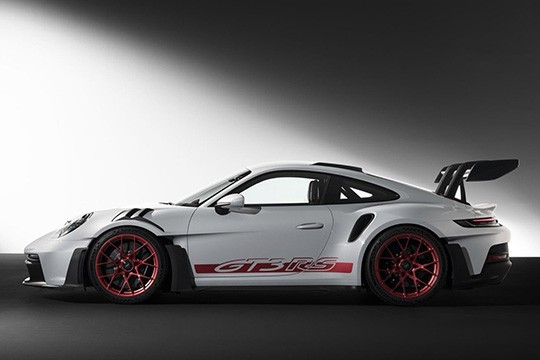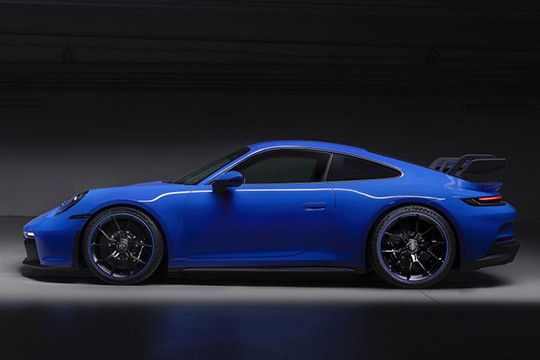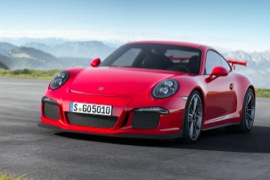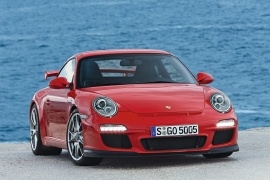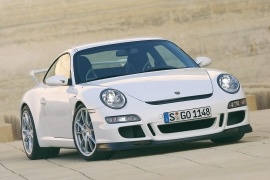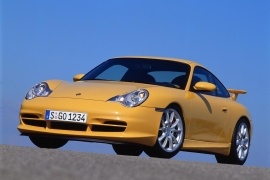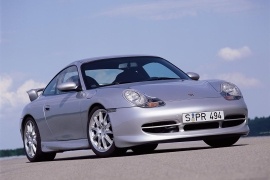PORSCHE 911 GT3 Models/Series Timeline, Specifications & Photos
First production year: 1999
Engines: Gasoline
Body style: Coupé (two-door)
For the German carmaker was another day at the office, but for the enthusiasts, it was another masterpiece for the roads.
Porsche didn't forget its roots and kept the 911 range on the market even though the internal-combustion engines were on the brink of extinction. But the carmaker continued on using its flat-six powerplant. It pleased its customers with a road-legal but a track-ready version of the 992 generation of the 911. It was the most hard-core version of its family.
With a design inspired by race cars, the GT3 RS featured a wild aerodynamic package that began with exhausts on the front hood and fenders. Its front bumper featured a broader grille at the bottom, allowing more cold air into the center-mounted radiator. On the sides, the crease on the front fenders and doors was inspired by the street version of the Porsche 911 GT1 Le Man car. At the back, the swan-type wing adorned the rear end. At the same time, the lower bumper sported a similar diffuser as the regular 911 GT3, with dual exhausts in the middle.
Inside, the standard carbon-fiber bucket seats fitted with race harnesses were standard. Also, the car featured a different steering wheel that allows the driver to make various settings for the car. They could adjust the bound and rebound rates, the eLSD (electronically-control Limited-Slip Differential), and the DRS (drag-reduction system) that lowered the car's aerodynamic drag for higher speeds.
The naturally-aspirated flat-six engine in the back provided 525 hp, which was sent to the rear wheels only via a seven-speed automatic (PDK – double-clutch) transmission.
Porsche didn't want to waste time and, at the beginning of 2021, introduced a new generation for its ferocious GT3 road-legal race-car.
Basically, the road-legal GT3 is the base vehicle used by Porsche to homologate the GT3 category race-version. While it was still based on the Porsche 911, it featured numerous modifications that made it lap the Nurburgring in 6:59.93 minutes, over 17 seconds faster than its predecessor. It was a marvelous time for a road-legal car.
One of the basic rules of a race car was to make them lighter, and Porsche tried hard to achieve the lowest weight for the GT3. It made the front hood, rear quarter panels, and roof from carbon-fiber-reinforced plastic (CFRP) as an option. The windows were slimmer, and most of the sound-deadening materials were gone. As a result, the GT3 tipped the scale at 1418 kg (3126 lbs) with a manual gearbox and 17 kg (37.5 lbs) more if fitted with the Porsche's PDK transmission.
Inside, the carmaker installed sport-bucket seats at the front and a bench for two in the rear. Porsche offered a Club Sport package that deleted the rear seats for those who wanted to race their cars, installed a 6-point harness, a roll-cage, and an extinguisher. The dashboard was carried over from the regular 911, but with a big, analog tachometer marked to 10.000 rpm, with a 9.000 rpm red-line. The rev-counter was flanked by TFT displays and, just above the center stack, a bigger touchscreen for the infotainment system.
Under the bodywork, Porsche installed a double-wishbone system at the front carried-over from the Porsche 911 RSR LeMans race-car and a reinforced rear suspension. The all-wheel steering made the car faster on the curves. The German carmaker ditched the turbocharged 3.0-liter engine from the regular 911 range and installed a 4.0-liter naturally aspirated flat-six to propel the car.
The 2017 Porsche GT3 was made for the customers who are racing their 911's but who want to enjoy the road to the race-track as well.
After the facelift for the 991 generation, the GT3 had to be enhanced along with the rest of the stable. The 991.2 GT3 was unveiled at the 2017 Geneva Motor Show and it was built more as a race-car that was able to roll on the road than as a supercar able to fight on a racetrack.
At the front, there was a new spoiler, with larger side-scoops. The center grille on the apron was split in three, with a larger center and two smaller vertical air-intakes. On the sides, the 10-spoke 20” light-alloy wheels featured center log-nuts. The ground clearance was reduced by 25 mm (0.98”) than the Carrera S. In the back, an adjustable fixed wing was installed over the engine lid.
Inside, the two-seat car a steering wheel carried-over from the Porsche 918 Spyder was installed. The Porsche Sports seats Plus with enhanced side bolsters were prepared for the occupants. There were three other options for the seats: an 18-way electrically adjustable adaptive Sports seat Plus, bucket-seats with adjustable seatbacks, and the hard-core carbon-fiber full bucket-seats. As in any 911 GT3, the rear seat pans were covered. The Porsche Communication Management (PCM) featured a special Track Precision app, that enabled the driver to analyze its track performance and enhance the race-lines.
Under the hood, the GT3 featured a naturally aspirated 4.0-liter engine, which offered 500 hp. It was paired with a 7-speed PDK (dual-clutch) automatic gearbox and a 7-speed manual was offered as an option. The rear-steering axle was fitted as standard.
In 2013 Porsche revealed the 991 GT3 at the Geneva Motor Show and it was an absolute blast for the Porsche fans. It was available only with a PDK (dual-clutch) automatic transmission that could change gears in 100 milliseconds and the car could lap the Nurburgring Nordschleife race-track in 7m22s on street-approved tires.
The look was different than a regular Porsche 911-991 generation. Its wider front track with a lower stance and special front spoiler improved the aggressive look. The carbon-fiber lip on the bottom of the apron, the mesh-grille on the air-dams, and the overall design were a promise for performance. A massive wing in the rear and the wide track were part of the GT3 story.
Inside, the fixed seat-backs carbon fiber sport-bucket seats forced the driver to stay in the race position. There were no seats in the back. Only a roll-cage to stiffen the car and to protect the driver in case if something goes wrong. The interior was covered in Alcantara, carbon-fiber, and aluminum. The instrument cluster featured a tachometer, a speedometer, and a round TFT display which could show various information for the car, or the navigation system.
The 3.8-liter flat-six fitted in the back had a rev-limiter at 9.000 rpm. It produced 482 hp and sent its energy to the rear wheels only. The rear axle-steering was another improvement over its predecessor. The front aluminum suspension and other modifications made to the car made it the fastest Porsche car of all times to that date. Even faster than the former glory Porsche Carrera GT, which lapped the Nurburgring in 6 seconds slower than the 2013 Porsche GT3.
In all of its history, Porsche built race-oriented vehicles to get an FIA approval for racing at various categories. The GT3 was just one of them, and it was the base version.
The Porsche 911 GT3 was built for those who wanted a car to race it around the track at the weekend and, maybe, to drive it to the circuit. It was comfortable enough to get its driver there and fast enough to get a prize.
The 2009 GT3 was the base model for a few versions of the GT3 (RS, RSR, R, or CUP) and it might be considered the most “civilized”. But it still looked brutal. The three wide front air-intakes on the apron and the exhaust scoop on the upper side of the bumper were specific for the RS3 lineup. On the sides, the sills were aerodynamically profiled to reduce lift, and in the back, the specific huge wing on top of the engine-lid created the necessary downforce to keep the car planted on the road.
Inside, the sport bucket seats were fitted as standard. The standard audio equipment was a system with CD and MP3 player and a 5” black&white display. The latest version of the Porsche Communication Management (PCM) was offered as an option, for those who wished to drive their GT3s on the road more than on the track. For the latter ones, Porsche offered a Clubsport package, which included a roll-cage in the back and a fire extinguisher. A general safety switch for the car was available as well.
The engine was a special 3.8-liter unit that offered 435 hp. It featured a dry-sump lubrication system, much needed on a track. It was paired exclusively with a 6-speed manual and power went to the rear wheels via an asymmetrical limited-slip differential.
The GT3 was proof that an owner didn't have to forget about comfort when driving a race-oriented Porsche, but it was still able to get very good lap-times.
While it wasn't a race-car with number plates on it, the 2006 Porsche GT3 came on the market with a package that could make its owners smile wide. It was built as a daily driver car, but with some PASM (Porsche Active Suspension Management) and other tricks could transform it in a split of a second from a sports-car to a race car.
For starters, the look was aggressive with a lower apron, a lip-spoiler underneath, and five air-intakes. An exhaust vent was placed on top of the bumper. The Porsche 911 GT3 came for the first time with a specially designed rear end. It featured centrally-mounted tailpipes, plus an additional air outlet openings at the rear. The twin exhausts were placed in the middle of the rear apron.
The standard interior of the GT3 was fitted with Alcantara on the steering wheel, the gear-stick, and on the handbrake knobs. The same material was applied to the center of the seats. As a reminder of the Carrera GT, the GT3 featured the dials with yellow needles and scales. On the tachometer, a GT3 logo was applied. Like its predecessor, the 996 GT3, it was fitted as standard with two seats. As an option, a roll-cage was available to increase safety and car's stiffness.
Despite having a smaller engine than the regular Carrera, which offered 355 hp, it offered 400 hp. On top of that, a sport-button provided 15 more horses between 3000 and 4250 rpm. For the transmission, the GT3 was fitted with a 6-speed manual, with either a race or a street-use gearing.
Two seats, no turbo, and, due to its lightweight, it was the quickest and the fastest naturally aspirated Porsche from its generation. And it was available with automatic transmission as well.
Apart from production vehicles, Porsche was one of the biggest suppliers for racing teams around the world. For some categories, the race models had to be built as the street-legal vehicles in order to receive an FIA approval. The GT3 was one of them and it was not just an ordinary car.
The design of the GT3 was different than the rest of its stablemates. The front bumper featured a special apron and a lip underneath. The sleek bodywork was carried over from the regular Carrera 2. It didn't feature any fancy air-scoops on its sides. The aerodynamically enhanced sills carried over the air-flow from the spoiler to the rear wheels. An adjustable rear wing was installed on top of the engine lid, to provide more downforce.
Inside, the GT3 was stripped from most of the comfort features. There was no bench in the back. Instead, it was fitted with a roll-cage, which provided more safety and a stiffer bodywork. The race-bucket seats were designed for track use. On the center stack, the GT3 kept the PCM (Porsche Communication Management) infotainment unit, but the AC was fitted as an option.
The GT3 engine was the same flat-six as the rest of the range, with a 3.6-liter displacement. It was enhanced to offer 380 hp, which was more than 100 hp/liter. The stiffer and lower suspension offered a better cornering speed. The standard transmission was a 6-speed manual, but a 5-speed Tiptronic (automatic) with paddle shifters behind the steering wheel was offered as an option.
To comply with the FIA regulations regarding the homologation of an FIA GT3 car, Porsche had to build a street version. And that is how the Porsche 996 GT3 appeared in the late '90s.
The 996 generation of the 911 was known as the first water-cooled Porsche. The new regulations regarding emissions and pollution forced them to drop their air-cooled engines. The interesting fact about the Porsche 911-996 was that the GT3 engine was not related to the other 911s from its time. It was closely tied with the Dakar and LeMans winner, the legendary Porsche 959.
The car's design was similar to the other 996 models, but not with the Turbo version. It didn't feature flared arches or big side intakes. It was a form that followed function at its best for the race version. It still had the 996 headlights, which were hated by all the Porsche fans. In the back, there was a slight difference between the 996.1 and the 996.2 versions. The latter featured a small duck-tail on the engine lid. It was considered to be useful in slower corners, but useless for tracks like LeMans, Sebring, but useful on the Laguna Seca.
The interior featured two bucket-seats, a dashboard, and a gearstick. Behind the seats, there was a roll-cage instead of the rear seats. Sound deadening was non-existent and no other comfort features were installed on the stock version. But Porsche offered a CD-Radio and climate control for no extra cost on the options list.
The engine was a water-cooled flat-six with a 3.6-liter displacement. It was mated to a six-speed manual gearbox carried over from the racing department and not from the standard 996 range. The suspension was stiffer for better high-speed cornering. The brakes were fitted with six-pot calipers in the front and four-pot in the rear.
